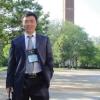Jiansong Zhang, associate professor Purdue Polytechnic’s School of Construction Management Technology delivered a keynote speech at the ISARC-CSCE/CRC-MOC 2025 Joint Conferences in Montreal, presenting his groundbreaking discovery of "Invariant Signatures," a new approach to solving a multi-billion dollar problem that has challenged the construction industry for decades.
The architecture, engineering and construction (AEC) industry has long struggled with a problem known as Building Information Modeling (BIM) interoperability. While different teams use sophisticated 3D models to design and manage projects, the software platforms they use often cannot communicate seamlessly with each other, leading to data loss, errors and significant financial costs.
Professor Zhang's research introduces a new paradigm called "Invariant Signatures of AEC Objects." This innovative method identifies a unique and unchangeable digital signature for each component within a 3D building model—such as a wall, a pipe, or a structural beam. Unlike previous attempts that focused on standardization, these invariant signatures allow different software systems to reliably identify and understand objects, creating a universal bridge for communication.
The significance of this discovery has been widely recognized. Zhang's keynote in Montreal follows his reception of the prestigious Daniel W. Halpin Award for Scholarship in Construction earlier this year, an award based on this groundbreaking work. The effectiveness of the invariant signatures approach has been demonstrated in multiple real-world scenarios across various AEC sectors.
Students at Purdue Polytechnic are already benefiting from this cutting-edge research. Zhang has integrated the theory and methods of invariant signatures into several of his undergraduate and graduate courses, including Construction Management Fundamentals and Interoperable BIM and Its Applications. This ensures that Purdue students are learning a solution to a major industry challenge before it has been widely adopted, preparing them to be leaders in the field.
Additional information
